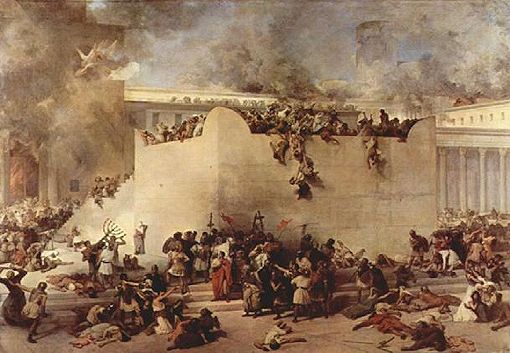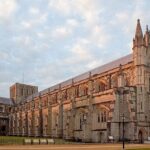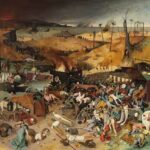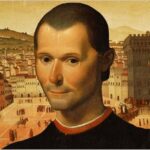Romans destroy the Third Temple of Jerusalem, leaving erect only the famous Wailing Wall. Rome troops abolishes the Jewish high priesthood
After a siege lasting 139 days, Jerusalem is taken but largely destroyed. The temple has already caught fire, in spite of Titus’ efforts to save it. The Jewish dispersal or diaspora begins with the sack of Jerusalem. The oral laws of Moses are added to the Pentateuch to form the Torah which will in future bind Jews together. Probable date for the writing of The Revelations of St. John the Divine (almost certainly not John the Apostle).
In 538 BCE, a proclamation by King Cyrus of Persia, who had conquered Babylon, permitted the exiles to return to Jerusalem. It was during the ensuing “Persian Period” that the Second Temple was built. The people were led by the towering figures of Ezra and Nehemiah. As the leader and governor of Jerusalem, Nehemiah required every family in Judah to send ten of its members to live in Jerusalem, thus augmenting the city’s meager population. Nehemiah’s great project was to rebuild the walls and fortify thecity.
Following the death of Alexander the Great, who in 333 BCE had vanquished the Persian Empire, his empire split into three kingdoms each ruled by one of his generals. At first Jerusalem and the rest of the country came under Ptolemaic Egypt, then passed to the Seleucid Syrians. Hellenistic culture, an amalgamof Greek and early eastern cultures, grew dominant under the Seleucids. Antiochus IV (175-163 BCE) declared Jerusalem a Greek “polis” = “Antiochia of Jerusalem.”
Some Jerusalemites, dubbed “Hellenists” by their detractors,adopted customs and attitudes deriving from Hellenistic culture. The situation was bound to create tension between the Greeks and Hellenistic Jews on the one hand and the traditionalist Jews on the other.
Antiochus’s religious decrees, which directly affected the Temple and ritual worship, enraged the traditionalists. In 168 BCE the Hasmonean revolt, led by Judah Maccabee, broke out. Jerusalem was liberated and the Temple was purified and restored as the people’s spiritual center. Some 20 years later, Simeon the Maccabee defeated the Hellenistic Jews, and ushered in an 80-year period of Jewish political independence in Jerusalem.
During the first generation of Hasmonean rule Jerusalem was still a small city, but subsequently, under John Hyrcanus and Alexander Janneus, Jerusalem expanded westward to encompass the Upper City (site of the present-day Jewish and Armenian Quarters).
A rift between Alexander Janneus’s successors enabled Pompey, commander of the Roman forces in the East, to seize the country in 63 BCE. In 37 BCE unbridled ambition and high-level intrigues brought to power Herod Antipater, under Roman patronage.
During King Herod’s reign (37-4 BCE) Jerusalem grew northward. Monumental building projects included the Second Wall, the expansive and magnificent Temple Mount, the Antonia Fortress andthe Citadel (today’s Tower of David). Numerous palaces as well as public buildings, such as markets, a theater and a hippodrome,enhanced the city. Besides large-scale construction, Herodian and late-Second Temple era Jerusalem witnessed religious and socialferment. Fierce controversies broke out between various sects and factions.
Jesus of Nazareth was active in this period. After gathering apostles and supporters in the Galilee – whose views often conflicted with the contemporary Jewish religious establishment -Jesus proceeded to Jerusalem where he was crucified as a rebel against Rome by order of the Roman procurator of Judea, PontiusPilate.
Following Herod’s death, Roman oppression, and with it Jewish resistance, intensified. Finally a revolt broke out, formented by the Zealots, who entered Jerusalem in 66 CE and held the city until the ninth day of the Hebrew month of Av, in 70 CE, when Jerusalem fell to the Roman legions under the command of Titus.
Thus the Romans’ protracted and unrelenting siege ended what had been a flourishing and splendid city. Jerusalem’s buildings were put to the torch and its inhabitants exiled.
This siege lasting 139 days left Jerusalem largely destroyed. Jewish diaspora begins with the sack of Jerusalem.








